Bird Alley: A Hostpot for Biodiversity
Discovery Park’s Bird Alley is properly named due its hotspot status for bird abundance and diversity. In Seattle’s largest park, this area is very high profile and visible to the public due its proximity to popular nearby trails. Seattle Parks and Friends of Discovery Park have built a new trail connecting the Capehart restoration and the South Bluff overlook. This trail is now open and connects the Capehart restoration and the South Bluff Overlook; an official opening will happen on May 11. Meanwhile, Green Seattle is carrying out restoration in the nearby “meadow.”
Our restoration will help fulfill recommendations outlined in the Discovery Park Vegetation Management Plan, focusing on blackberry management, invasive species control, wildlife enhancement, and native plant community enhancement of a unique mixed conifer-broadleaf forest. We are promoting Pacific madrone (Arbutus menziesii) and Garry oak (Quercus garryana) as a co-dominant tree species – due to the site’s proximity to high Puget Sound bluffs – as well as other pollinator-friendly understory species. While establishment of keystone tree species is important, increasing forb diversity is desirable for enhancing wildlife habitat and aesthetics for people using the new and nearby trails.
History of Discovery Park
It wasn’t until the 1970s that the United States Army conveyed much of Fort Lawton to the City of Seattle to become Discovery Park. While the land had been developed heavily in some areas to serve the military, prolonged periods of “underuse” after each war effort left much of the forest to regrow after timber harvests in the late 1800s. The 1936 Aerial Imagery from King County shows the project site predominantly covered in grasses, with few trees scattered on this flat terrain above the high Puget Sound bluff. Beginning in the late 1950s, the Federal Aviation Administration and National Oceanographic and Atmospheric Administration operated a radar installation and antenna facilities respectively in the same vicinity as the project site.
Habitat Enhancements of Bird Alley
Wildlife enhancement and native plant community enhancement will continue to be benefits of, and key drivers of restoration in Discovery Park. Seattle Audubon’s Neighborhood Bird Project has recorded several hundred species in Seattle City Parks; and species diversity is highest in Discovery Park with 207 species. Battey and Ross cautiously state that recent restoration activities on bird life has been positive. “As more restoration zones are completed, we expect that patterns of increasing species diversity will continue” (2014, p 15).
The restoration site lies on the southwestern edge of the Bird Alley management area. This portion of the management area has a PNW savanna-type structure with sparse, young native trees. Crews planted numerous sparse Douglas-fir and shore pine approximately five years ago during the initial Capehart restoration – they are now 5-7 feet in height thanks to a few years of early establishment.
When EarthCorps crews started working in the area in April 2018, several informal footpaths traversed the meadow dominated by exotic grasses. There are some substantial patches of non-native invasive blackberry and small patches of native blackberry too. The crews also worked hard to install several Hügelkultur mounds on the eastern edge of the meadow by burying woody debris and organic material. We will plant directly into these mounds, which should provide a decent reserve of nutrients and moisture for seedlings for the near future.
Native Plantings for Native Wildlife
In late October 2018, Seattle Parks Turf Crew lightly tilled soils in the area, avoiding existing trees and the Hügelkultur mounds. This prep work loosened the sod of non-native grasses; then the crew spread a native wildflower mix in advance of mid-winter plantings comprised of: yarrow, lupine, rose, snowberry, goldenrod, thimbleberry, native grasses, and balsamroot (of the sunflower tribe). People will notice the phenology of this species’ mix flowering first thing in the spring and then throughout summer 2019.
By the end of March, crews and volunteers had planted over 4,000 additional native forest species in the meadow augmented by plantings along the new trail corridor. To cap it off, Seattle Parks and Friends of Discovery Park were able to have Seattle Conservation Corps dismantle the decades-old chain link fencing and disappear the east-west social trail that used to border the old fence line. Planting into the old path will discourage off-trail travel and promote use of the new trails in the area.
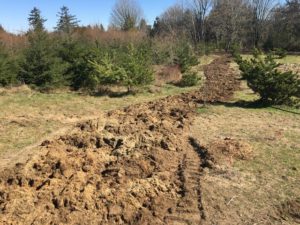
Fences are finally gone! Crews tilled the former social trail and planted with natives on their way out.
Be a Part of the Magic
This tag-team effort is a major investment in one of Seattle’s favorite parks. Expect to see crews out in the meadow weeding and watering this spring and summer. Feel free to give them high-fives and cookies.
You can get involved with regular work parties with Friends of Discovery Park in the area pretty much all-year round. Click HERE to find an upcoming Discovery Park event where you can volunteer and dig in!

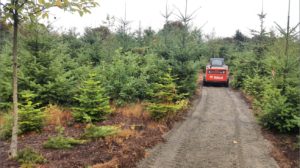

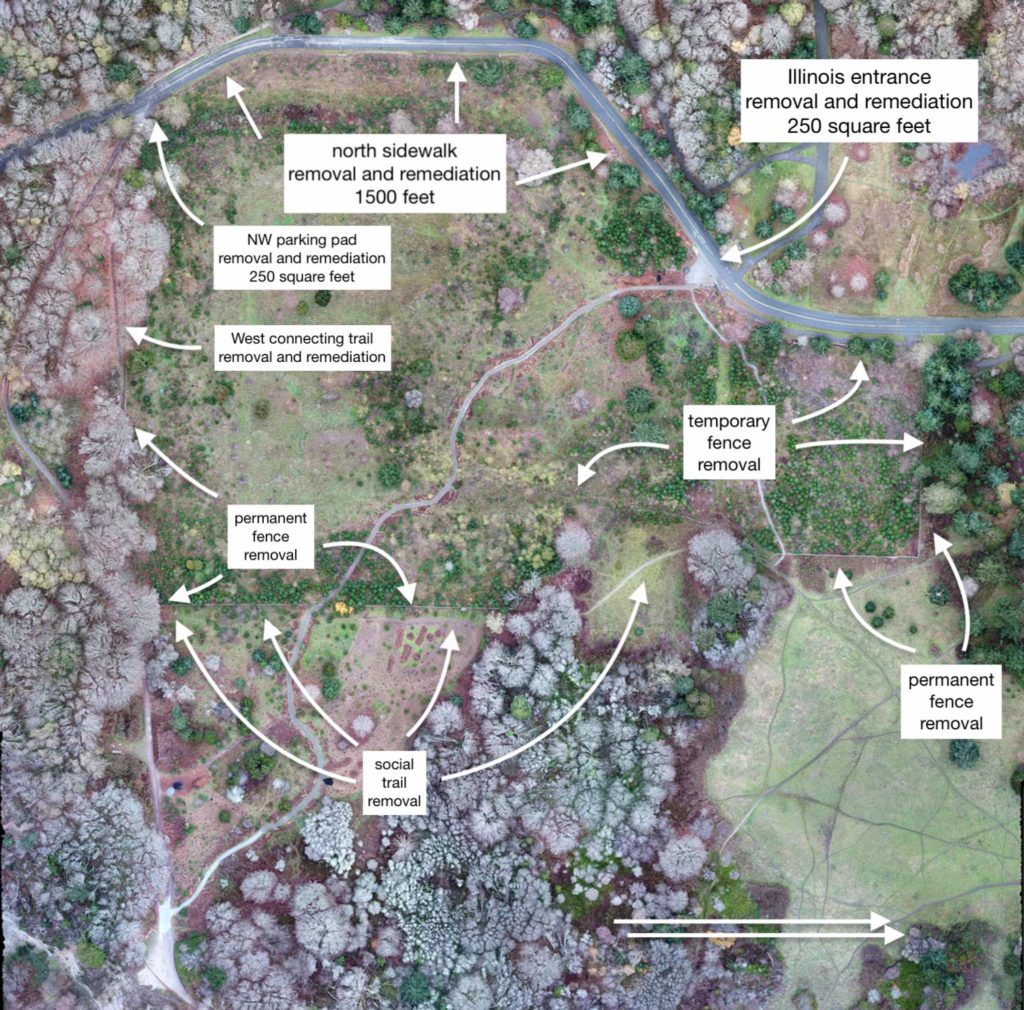
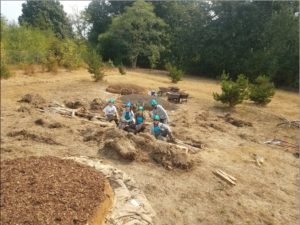
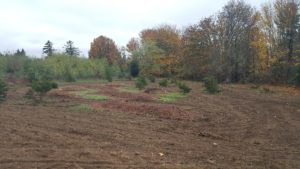
Nice write-up, Michael. I appreciate the work you and the team are doing/have done in the park. I’m curious to learn more about the madrone promotion project; how is that being done? Aren’t madrones difficult to propagate? Cheers.
Thanks for noticing, Michael! I appreciate your interest in madrone. One can read more about the madrone recovery project by searching “madrone” in the search field top right of the website. Also, we are collaborating on a regional parallel effort called Arbutus ARME that recently got a write up in Discover magazine about what we are doing to map the range of the species and track the health of trees.
Propagation of the species takes patience and slightly different methods. There are a few courageous growers around the Puget Trough, like Firetrail, Seattle Native Plants and Woodbrook. We are growing it locally too; Seattle Parks Horticulture Facility is growing the species from seed we collect in the parks with a lighter soil mix and we are growing the plants out to a taller size so the foliage is up of the ground when we outplant them and less susceptible to pathogens. Keep your eye on the WSU Plant Pathology website where we will be posting new factsheets that bring better practices of madrone propagation together again.
Interesting stuff, thanks, Michael. See you on the trails.
Public access equals public benefit. Thank you to all who worked so hard on Capehart Restoration. Last piece is to Annex Fort Lawton to Discovery Park according to Master Plan of 1972. Greenspace for future generations.
Hi Michael, please put some time and effort towards supporting the addition of Fort Lawton to Discovery Park. All of that work that Green Seattle In the trails and by extension the elimination of public access to many areas of Discovery Park means that in the not too distant future that there will be a lower level of use available to the public when they come to Discovery Park. Already the Fort Lawton property is being used for special event parking by the Seattle parks department. If that is already occurring and the growth of Seattle is continuing on abated, it is clear that discovery Park will not be immune from experiencing a degradation of its general landforms and even it’s facilities such as the trails. It is not so big that it cannot fail. 34 acres would go a long ways towards ensuring Discovery Park’s integrity and its value as a park and source for human rest and relaxation.
Hi Elizabeth:
My Unit at Seattle Parks and Recreation works for the Mayor, and the Fort Lawton Redevelopment Plan is currently a project of City of Seattle Housing. If the plan entailed forest restoration, we would be in there for sure! At this time, it doesn’t appear to be the case.